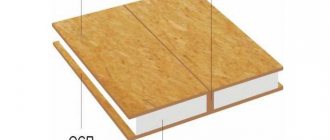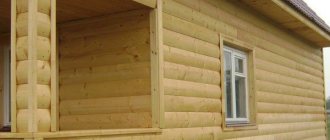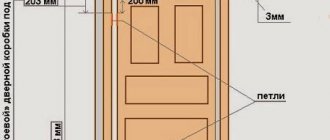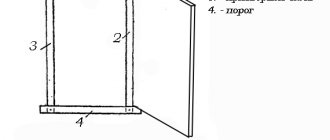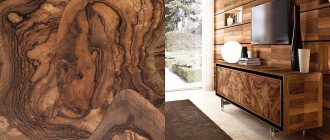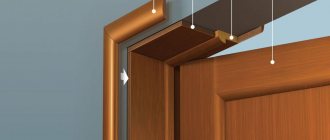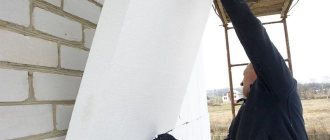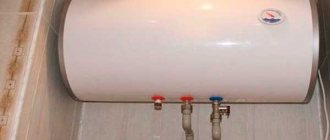Plastic as a material
Wall decoration with plastic panels has its advantages and disadvantages. They must be taken into account when making the final decision. The finishing material has the following advantages:
- Absolutely harmless. Many people are afraid of plastic because it is an unnatural material. Modern technologies that make it possible to produce harmless products are simpler and cheaper than old ones. For this reason, it is extremely difficult to find dangerous material even among fakes.
- The wall panels for interior decoration are very beautiful. There are many options for colors and textures. In addition, manufacturers are releasing new seamless options that are very different from the usual office panels. You can choose a wood finish, plain or colored. Photo printing is also applied to the coating.
- Possibility of use in cramped conditions. Plastic panels for interior decoration are perfect for various niches and other corners of an apartment or house where it is inconvenient to work with other materials.
- The panels are easily mounted together with ventilation grilles and sockets. In any color, these elements look natural and are not noticeable.
- Plastic is perfect for finishing bathrooms and other wet rooms. The finishing of walls and ceilings is durable, does not require complex maintenance, and can be used at low temperatures (for example, on an uninsulated balcony).
PVC panels look pretty good for their price.
The disadvantages include the following negative points:
- Flammability. The material is difficult to set on fire, but when exposed to fire it maintains combustion and releases a large amount of gases dangerous to humans.
- The panels don't breathe. They completely block the movement of air through the walls, which is necessary to ensure normal ventilation. Because of this property, the type of finish is not recommended for use in the bedroom and children's room.
- Insects can live in the voids of the panels. This problem is especially relevant for the southern regions.
- The need to use special tools for cutting and certain skills during installation.
- Decorating walls with PVC panels with your own hands requires careful preparation of the base.
The finishing can look very non-trivial!
Having considered all the advantages and disadvantages of the material, you should calmly make an informed decision about the possibility of using this type of finish.
Advantages of façade cladding panels
The method is used as a cheap alternative to decorating walls with ceramic tiles, natural wood, and wild stone. Paneling has several advantages:
- You can install the support and assemble the canvas with your own hands;
- assembly of the structure is carried out quickly;
- low cost of plates and component materials;
- plastic is durable and easy to clean;
- finishing insulates the building.
A big plus of decorative panels is their diversity. There are models on sale in different colors. Before installing facing slabs, there is no need to plaster or level the surface of the walls.
The panels bend and break from impact. A damaged facade cannot be repaired in parts. For restoration it is necessary to completely dismantle the decorative wall.
High-quality structures self-clean under rainfall and retain technical and operational qualities when exposed to seasonal temperature fluctuations. The hanging fabric does not rot.
What tools will you need?
It is worth preparing to work with PVC panels. First of all, you will need to find a special tool:
- Circular Saw. If you can’t find it, you can use a jigsaw. The file or disk must have fine teeth (“clean cut”). It is preferable to use a saw. The jigsaw file is highly flexible, so the cut can turn out wavy.
- Jigsaw cutter with angles of 45 and 90 degrees.
- Construction stapler for cladding on wooden sheathing.
- Rubber mallet with a hook rule. The same tool is used for installing laminate flooring. Needed to “rip out” jammed panels. Doing this with your hands can easily damage the panel or sheathing.
- A plaster spatula used to bend the finishing profile when installing the last plank. Spatula length 80-120 cm.
Also when performing work you will need:
- pencil and tape measure;
- building level;
- square;
- fastening elements (self-tapping screws, dowel-nails, clamps);
- screwdriver;
- perforator;
- sealant;
- antiseptic.
Types of facade panels
Stacked body kits for decorating facades are a constructor made from individual elements. The parts are sequentially installed on the frame. The base for the plates is made of wood or metal.
Some types of cladding are attached to the wall with adhesive mixtures. With this installation method, there is no gap left between the wall plane and the facade panel.
Home owners have the opportunity to choose the material of a suitable design. There is material on sale that imitates:
- logs;
- decorative brick;
- wild stone;
- ceramic tiles;
- boards.
Plates can:
- have a different texture, color;
- made from various raw materials;
- be installed vertically or horizontally.
Panels are classified by:
- material;
- form;
- method of fastening.
Guide elements, insulation, and fasteners are sold complete with cladding parts. Cladding parts are made from:
- wood;
- metal;
- plastic;
- ceramics;
- PVC (vinyl and polyurethane);
- glass;
- composite.
The most common types of panels are made from PVC, metal alloys and wood. Each type of product has its own pros and cons.
Wooden cladding sheets are made from sawdust and wood fibers by pressing. This building material is durable and wear-resistant. Wood provides good heat and sound insulation.
Wooden panels quickly deteriorate when exposed to moisture.
A polymer coating is applied to the outer side of the cladding made of aluminum, galvanized steel alloys. The color of the finished sheets can be any. Body kit elements are:
- flat;
- corrugated;
- ribbed;
- perforated.
Metal cladding has a number of advantages, it:
- durable;
- durable;
- not prone to fire;
- resistant to sunlight;
- not subject to corrosion.
The strength and durability of plastic panels depends on the quality of the raw materials. They are not expensive, but in terms of reliability and wear resistance they are inferior to cladding made from natural materials.
Glass is used to decorate expensive mansions and city high-rises. The material undergoes special processing. Glass canopies are expensive.
There are modern technologies for the construction and finishing of buildings using Canadian technology from EcoPan panels. The slabs act as a finishing facade and building material at the same time. They are used for the construction of walls and partitions.
Single layer
The cheap design consists only of decorative strips and sheets. It is not necessary to construct a frame for the façade panels. The plates can be glued directly onto a plane. There are no voids formed between the outer cladding parts and the outer wall.
Multilayer
Sandwich panels are assembled from two sheets 0.5 mm thick. A layer of insulation is placed between the plates. Multilayer structures are made from metal alloys with the addition of magnesium and manganese.
The design does not lose its functional qualities for 20 to 30 years. The plates are installed using self-tapping screws. The panels are joined together using a tongue-and-groove system.
Composite panels have a multilayer structure. The outer layer of structures is made of:
- clinker tiles;
- aluminum;
- fiber cement.
The slabs differ according to the type of filler. Composite cladding is used in private construction.
Installation of plastic panels for wall decoration
Plastic can perfectly replace wooden decorative elements and other finishing options. But it must be fastened in strict accordance with technology. Decorative wall panels will help make your home cozy and beautiful.
3 ways to attach panels to the wall
The walls in the bathroom and other rooms, as well as the ceiling, are decorated with plastic panels in the following order:
- preparation of the base;
- marking;
- lathing device;
- installation of start and finish profiles;
- installation of all other planks;
- facing of slopes;
- fixing skirting boards.
Installation instructions for PVC panels
Preparing the base
Work with plastic begins with removing the old coating. In order for the finishing coating to have an attractive appearance without distortions and other troubles, you will need to carefully seal all the cracks in the walls and ceilings and eliminate any unevenness.
Cleaning the surface of the walls is necessary to prevent the appearance of dust, mildew and mold
Next, the base is covered with a layer of antiseptic composition. It will help prevent mold and mildew from appearing under the panels.
Marking
Before finishing the room, it is necessary to determine the location of the frame racks . Finishing ceilings and walls with plastic panels involves marking in the following order:
- Mark a point at a distance of 1-2 cm from the level of the floor or walls. A line is drawn along the perimeter through this point. For marking accuracy, use a building level.
- When marking walls, the same line must be drawn under the ceiling.
- From the bottom line, in increments of 40-50 cm, parallel lines are drawn to the entire height.
This marking is suitable for attaching panels vertically. The cladding is always attached perpendicular to the frame, so if it is necessary to arrange the cladding elements horizontally, vertical markings are made.
Horizontal and vertical installation types
Sheathing device
Most often, wood is used as lathing for panels for interior wall decoration. In this case, the slats must be treated in advance with an antiseptic composition to protect them from destruction. Using a puncher, holes are made along the marking lines for fasteners with a distance of 50 cm. The frame slats are secured to the wall. If it is necessary to lay wiring under the trim, this must be taken into account at this stage:
- provide fastenings for wires;
- check that they do not protrude beyond the plane of the sheathing.
Be sure to check the horizontality of the sheathing.
When using a metal C-profile as a sheath, you will need to additionally purchase elements for fasteners. They are usually sold as a set. The metal is fixed to the base with self-tapping screws in dowels. All work must be performed in accordance with the manufacturer's instructions.
To increase the thermal insulation or sound insulation of walls, special mats can be laid between the frame slats. They are fixed depending on the type of material used. For different types, both fastening with dowels and with an adhesive composition can be used.
Fastening the slats
The first plastic strip needs to be secured in the most illuminated and visible corner. Most often, this is the one located opposite the entrance to the room. Measurements are taken using a tape measure. The panel is cut to the required length with a special tool (usually a circular saw).
One edge of the strip is inserted into a special side molding. This element is designed to ensure mutual fastening of the panels, which are located on opposite sides of the corner. The element with the molding is applied to the corner and secured to the sheathing on the back side.
Next you need to connect the first panel to the second. To do this, a tongue-and-groove system is again used. The joint is pressed tightly and the plank is fixed to a wooden or metal frame. All subsequent elements are mounted using the same technology. To ensure maximum tightness of the joints, it is recommended to lubricate the side edges with silicone before installing the panel. When installing the last part, it is worth checking whether it is the right width. If necessary, the element is cut to width. The last panel is not secured to the sheathing. It must be snapped onto the finishing element. If necessary, all joints are treated with silicone (sealant).
Installation of panels on the frame using clamps and clips
Accessories must be installed to complete the installation. Such elements include baseboards and their caps, corner elements. The latter are purchased together with the panels and heated on top of them.
Accessories for panels will give your decoration a neat, finished look
To make holes for switches and sockets, use a sharp knife. They cut out holes of the required size.
Installation of panels with glue
If necessary, finishing elements can be fixed directly to the wall without the use of lathing. In this case, increased requirements are placed on the foundation. It will take more time to prepare it, since the surface must be perfectly flat.
Before starting work, purchase special glue. It is allowed to use liquid nails for installation. It is important to check the composition of the substance in the store. It should not contain solvents that destroy plastic elements.
Installation of lamellas with glue
The work is performed in the following order:
- cleaning the base from old cladding;
- treatment with antibacterial putty or a layer of primer that contains components that can protect against mold and mildew;
- drying the base;
- preparation of the adhesive composition in strict accordance with the manufacturer’s instructions on the packaging;
- the choice of working tool is carried out depending on the consistency of the glue: roller, brush, spatula;
- work begins with corner elements;
- the glue is applied to a small area at a time (equal to approximately 1 panel) so that it does not have time to dry;
- a corner piece is secured to which an ordinary element is mounted using grooves;
- the panels are pressed against the wall with your hands for a short time, during which the adhesive solution has time to set;
- install all other panels;
- install decorative elements, coat the seams with silicone sealant.
Preparatory stage
Cladding with PVC panels
Preliminary calculations
You need to start by calculating the amount of finishing material so that you don’t have to overpay or go to the store for an additional batch. The panels can be mounted both vertically and horizontally, depending on the wishes of the apartment owners. When mounting vertically, the number of panels is calculated as follows: measure the length of the perimeter of the room, subtract the width of the openings and divide by the width of one panel. To the resulting number add 2-3 lamellas in reserve.
For horizontal installation, measure the area of the room minus door and window openings and divide by the area of one panel. Here the margin should be at least 10%, since the consumption of material for trimming increases. Additionally, you need to calculate the number of slats for the sheathing and fasteners. First, the height of the walls is divided by the sheathing pitch, which is usually 0.5 m, and multiplied by the perimeter of the room. The resulting number indicates the length of the slats in linear meters. By measuring the height of the corners and multiplying it by their number, we obtain the total footage of the corner profiles; to this number you need to add the perimeter of window and door openings.
Methods for attaching lamellas
How to attach PVC lining to walls
There are three ways to attach panels to the wall - using glue, self-tapping screws and clamps. The first method is suitable for very even and smooth walls; glue is used special for PVC, universal “Moment-installation” or “liquid nails”.
Installation of panels with glue
The use of this method simplifies and reduces the cost of the installation process, since there is no need to attach the sheathing. Disadvantages: it is impossible to replace a damaged panel; during subsequent repairs it is difficult to remove the covering from the wall.
Methods for installing PVC panels on walls
Do-it-yourself installation of PVC panels
Fastening with self-tapping screws is a reliable and convenient option that does not require a perfectly flat surface. To screw in the screws, you definitely need a screwdriver, otherwise the installation process will take a long time. Disadvantages of this method: a wooden frame is better suited for self-tapping screws, so additional time is spent cutting the timber and treating it with an antiseptic.
How to attach plastic panels
The third option is the most optimal. The clamps are conveniently and quickly attached to the sheathing and securely fix the panels to the wall. The lathing is mounted from a metal profile, assembly of the covering is carried out effortlessly. A damaged lamella can be easily replaced with a new one; dismantling the finish also does not take much time.
Installation of PVC panels
Tools and necessary materials
During the work, everything should be at hand, so materials and tools for installation are prepared in advance. You will need:
- fine-toothed hacksaw;
- pencil and tape measure;
- level;
- square;
- plastic panels;
- slats or plastic profile;
- dowel-nails, screws or clamps;
- screwdriver;
- perforator;
- antiseptic composition;
- sealant;
- ceiling plinth.
Preparing the walls
Before covering the walls with panels, you need to clear the old coating, seal every single crack, smooth out noticeable defects and treat the surface with an antifungal agent. Thanks to this, dust will not accumulate under the plastic and mold will not develop, which negatively affects the microclimate in the room. If the installation will be carried out on a frame, it is not necessary to additionally level the surface.
Prices for mixtures for leveling walls and ceilings
Mixtures for leveling walls and ceilings
General recommendations
In addition to installation with glue and lathing, there are several other methods that professional workers use. But they have not become widespread. In conclusion, we can give some general advice:
- The panels are recommended for finishing balconies, loggias, bathrooms, hallways and living rooms. For bedrooms and children's rooms, you should pay attention to more breathable materials.
- It is best to use seamless plastic in rooms with air conditioning or a forced ventilation system.
- In a bedroom for adults, it is permissible to use the material for certain sections of the walls.
- It is not acceptable to use the elements in the kitchen. In this case, grease and other substances will settle on the surface of the panels, which will become an excellent breeding ground for bacteria.
What are the panels for?
Wall curtains are used for:
- decorating the technical layer;
- facade decorations.
Voids form between the plates and the wall. Insulation is installed in them. Finishing a house with facade panels allows you to decorate the external walls and reduce the loss of thermal air in the premises.
Hanging structures protect walls from wind, dust, dirt, and moisture. The panels are durable and strong. They allow you to insulate the building and increase the sound insulation of the walls.



